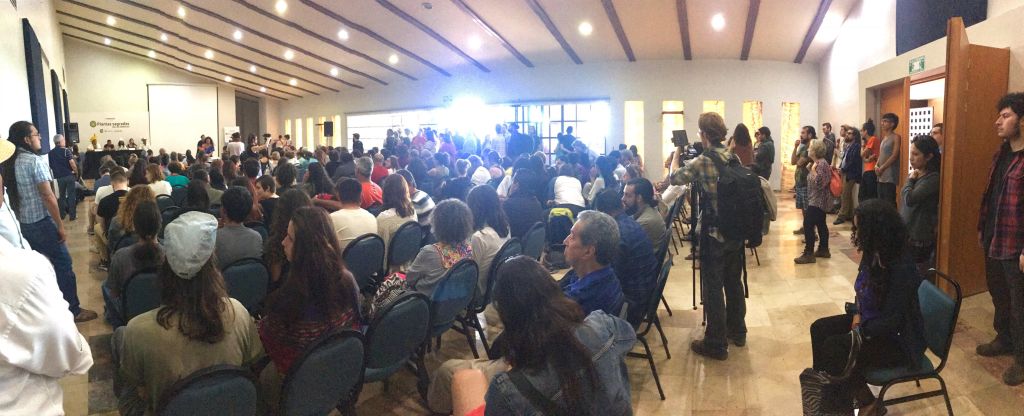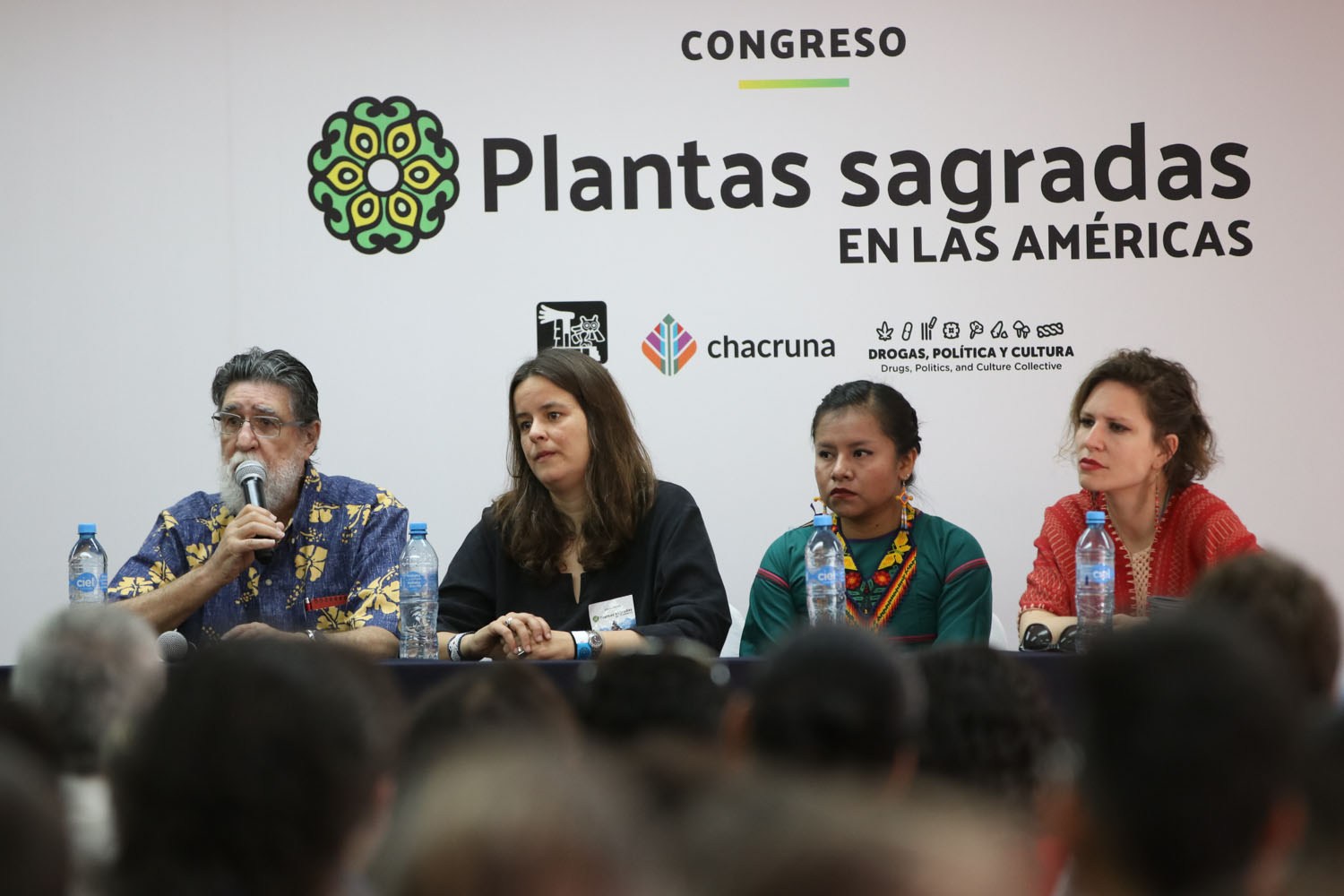- Why Land and Ecology Matter for Global Psychedelics - January 25, 2024
- Coming of Age in the Psychedelic Sixties - March 15, 2022
- Psychedelics, the War on Drugs, and Violence in Latin America - March 10, 2022
On Sunday, February 25, the closing ceremony for the Conference on Sacred Plants in the Americas was celebrated in the Mexican lakeside town of Ajijic, Jalisco. The conference room overflowed with an audience that anxiously awaited the keynote speakers. Lead organizer, Dr. Bia Labate, motioned that the people she had invited to the front of the room were some of the indigenous tribal representatives participating in the event: medicine women and men, lawyers, small farmers and correspondents. Leopardo Yawa Bane (Huni Kuin) had traveled from Brazil to give a talk on the globalization of ayahuasca, but, as a practitioner and the son of a traditional chief, he closed with a song. On the stage, he was accompanied by Felipe Fuentes, sipáame or Rarámuri healer; Mamma Senchina Kogi, “ancient-knower” from Colombia; Lila and Laura López Sánchez, onayas (Shipibo healers) from Perú, among others. During this closing ceremony, the calls for decolonization that several of us referred to during our talks were upheld through the songs that many of the keynote speakers shared. Furthermore, the unusual format of this closing illustrated the central relationship that both ancestral knowledge and territories have with a diversity of psychoactive plants. Within this geography, Mexico is the country with the most density and diversity of these plants. The songs brought about a type of euphoria following a program that had lasted two and a half days and included almost 150 talks dealing with political, cultural, and environmental topics pertaining to sacred and psychotropic plants.
Recalling the term used by Jose Martí to refer to this hemisphere, Dr. Andrés Fábregas Puig emphasized in his opening words that the roots of so many of these plants lay here in “Our America.” Yet today, uses of these plants have surpassed geographical borders, and this last fact was the most debated issue within the conference’s panels. As both traditional and contemporary sciences continue to establish the curative potentials of these plants, the politics surrounding access and consumption make their use increasingly problematic. This debate can perhaps be reduced in the following manner: For some, this opening of borders is part of a welcomed and growing sense that psychoactive plants are part of a universal heritage; but for others, this opening instills new forms of opportunity for exploitation of the indigenous communities that have historically cared for these plants. Consequently, this shift is not necessarily an indication of a newfound universal freedom for all of its users; in fact, for indigenous peoples and territories, increased global consumption presents a new battlefront, as sacred plants become one more resource that needs to be protected from overexploitation.
Peyote’s Sacrifice
These tensions were clearly present during the various panels dealing with peyote and, by extension, many discussed the centrality Wixárika culture has with this plant and the consumption practices reproduced and transformed by other demographic groups, notably the Native American Churches of North America and Mexico. It is important to point out that the conference took place in Xapawiyemeta, one of five Wixárika cardinal points that is marked by a xiriki or small shrine on Lake Chapala’s Island of the Scorpion (Isla del Alacrán). Our placement within the Wixárika territorial complex [see map] did not go unnoticed for some of us who were present. This was particularly true because during these same days we relived some of the sharpest tensions that make up what has become a continuous struggle for the protection of Wixárika sacred territories. These sacred sites are inhabited not only by the paths of the foundational ancestors of the Wixárika people, but they are also the sites of unquantifiable ecological value and the target of extractive projects that include mining, hydroelectric dams, and, the most benevolent of them all, tourism.

Wirikuta is the sacred Wixárika pilgrimage site located in the extraordinary semi-desertic plateaus of San Luis Potosí, and the peyote cactus is endemic to this highly biodiverse ecosystem within the Chihuahuan Desert. But here, too, sit mountains with gold and silver deposits, tracts of land that are seen as exploitable for export monoculture, and small farmers who have had to negotiate with the presence of businessmen, politicians, and tourists who bring with them their own imaginaries of what needs to be done to develop “the magical land of peyote” (here I make reference to the 1968 book of the same name written by Mexican journalist Fernando Benítez).
In this sense, while the closing ceremony was defined by a decolonizing format, the first day of the conference transpired with brushes between Wixárika presenters—who articulated a millenarian vision of Wirikuta as a vital space for cultural reproduction—and the unexpected arrival of representatives from First Majestic Silver, Inc., the Canadian company that, since 2009, has sought to exploit the minerals found in this sacred region. Without admitting their sponsorship from the mining company, these representatives included small farmers from the semi-desert and members of the Wixárika ethnic group. This team did not exactly come to speak about peyote, but to affirm that mining is merely a tool for development that does not threaten peyote’s habitat. Accordingly, the true culprits of peyote’s degradation were the conference’s audience that had raised their hands admitting prior consumption of the cactus, and the activists that have defended Wirikuta from extractive and polluting activities. Above all, they demanded that Wixárika authorities cease their resistance by putting an end to the legal injunctions against mining activities. After a long day of confrontations, the First Majestic Silver team left the conference, leaving behind traces that would continue to shape our conversations.
It is a case reminiscent of the background story for the current blockbuster hit, Black Panther, where the territory of Wakanda holds in its core an extraordinary mineral (vibranium) and a plant with heart-shaped leaves and a purple flower reminiscent of Ololiuqui, also known as morning glory. The protagonist, T’Challa (Chadwick Boseman), is shown drinking a potion made from the flower prepared by a shaman, played by Forrest Whitaker; this beverage then transports Black Panther to the world of the ancestors. The superhero obtains his powers from the properties offered by the flower and the metal. But the script revolves around a discussion of whether Wakanda should open itself to the larger world and generously offer the benefits of its well-protected territory. The chaos that the rest of the world lives in puts into question the place that Wakanda holds. Should it be sacrificed for the good of humanity?
An Integral Vision and the Politics of Respect
In this interdisciplinary and intercultural space, we could not simply talk about peyote as an isolated plant. Wixárika lawyer, Santos Rentería pointed out with precision that, for the Wixárika, peyote is part of a whole. It is part of a mythological territory that reifies itself through the intergenerational walking of pilgrims who retrace the steps of their ancestors, presented as geographical coordinates in places that we now call Nayarit, Jalisco, Durango and San Luis Potosí. It is part of a collective practice linked to rituals that call on agricultural cycles and, in this manner, call on the cycle of life itself in its most primordial aspect. For the Wixárika, peyote is not merely a plant with therapeutic and identity-enriching properties: it is life itself.
An undeniable reality was presented through these intersecting perspectives:
peyote is in danger.
How do we, then, articulate the good use of a sacred plant, while taking into consideration these socio-cultural tensions? How do we articulate its conservation in the face of so many offensives that play out at different scales? The panelists made clear that the present and future impacts on peyote’s habitat are not simply the effects of small and large scale consumption, but also a product of big capital projects like mining, gas pipelines, and industrial agriculture. But we also discussed how this ecological pressure goes hand-in-hand with the pressure placed on Wixárika people since the end of the 1960s, when their culture increasingly became commodified because of its relationship with peyote, its traditional shamanic practices, and their aesthetics linked to these same practices. The global consumption of peyote has had the effect of making mara’akate, or shamans, increasingly sought-after by external actors seeking to legitimate their own desires in a process that markets indigenous spiritual culture. And, as if this were not enough, domestic and international policies have only criminalized “bad uses” of peyote, while turning a blind eye to the destruction of its ecosystem.
The weight of this reality during the third day of the conference was overwhelming. The songs in various indigenous languages offered during the closing ceremony created hemispheric links within the audience, as if threading us together across the different traditions that have incorporated these protagonistic plants. The weight of this reality then sought action, and this action was marked with urgency by Aukwe García Mijarez, from the Wixárika Regional Council for the Defense of Wirikuta. This young Wixárika leader retold the lyrics of a song about a Wixárika man who decides to follow his traditions by taking the mythic pilgrimage to Wirikuta. However, once he is in that Eastern land, he cannot find a single híkuri, and this absence becomes a cry and then a moan. Aukwe’s retelling also became a cry because, for the Wixárika, this plant and its reduction is more than an unfortunate consequence of globalization, it is the loss of a central being—it is the loss of a Whole. And, because of this, Aukwe demanded that peyote be respected, that the protection of Wirikuta be respected, and, as a result, that Wixárika cultural autonomy be respected.

It is in this way that the closing ceremony was transformed into an assembly where we all stood in relation to one another to face the difficult future that we share unequally. For indigenous peoples, the reduction and loss of their territory, their plants, and the practices associated with these is a multi-dimensional threat. We must recognize the specificity of this problem and our positionality with respect to the solutions. The project “Hablemos del Híkuri” (Let’s Talk About Peyote), presented in the conference by Lisbeth Bonilla y Pedro Nájera, and winner of the prize for best article on the Drugs, Politics and Culture Collective blog, is an example of how we can unify forces and complement different forms of knowledge to restore peyote’s habitat and educate different audiences about its fragile state, proper forms of harvesting, and the need for new users to find paths of consumption through cultivation. We cannot let Wirikuta and other biocultural regions of the world become sacrificed for short-term desires. If these plants are to continue to gain visibility as a positive force for humanity, we must first tend to the political, cultural, and ecological realities that impact them.

Reference
Benitez, F. (1975). In the magic land of peyote. Austin, TX: University of Texas Press.
—-
Note
This paper appeared originally in Spanish here.
Take a minute to browse our stock:
Did you enjoy reading this article?
Please support Chacruna's work by donating to us. We are an independent organization and we offer free education and advocacy for psychedelic plant medicines. We are a team of dedicated volunteers!
Can you help Chacruna advance cultural understanding around these substances?
Become a Chacruna Member
To make a direct donation click the button below:
Wednesday, June 9th, 2021 from 12-1:30pm PST
REGISTER FOR THIS EVENT HERE
There is growing enthusiasm in Jewish communities about possible ancient use and modern applications of plant medicine in Jewish spiritual development. Psychedelic Judaism introduce new potential modes of healing...











